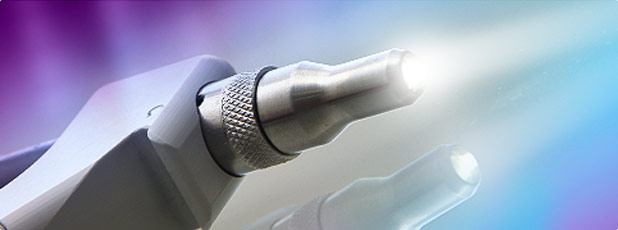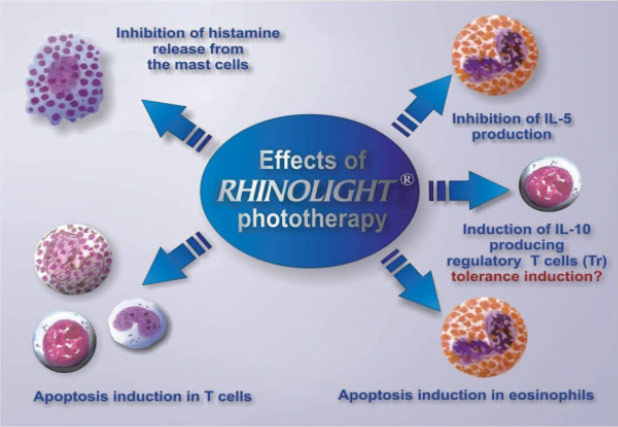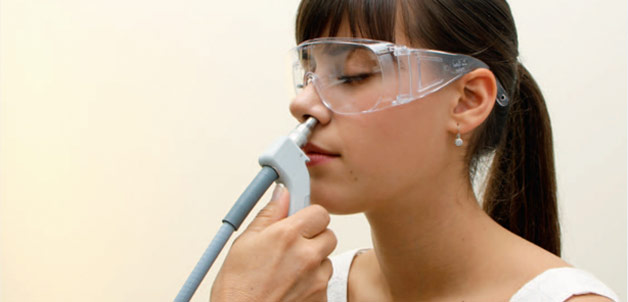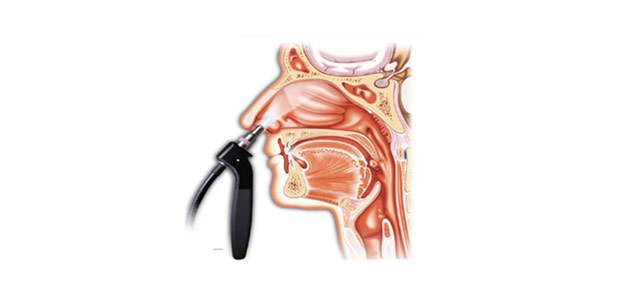
U/V phototherapy for nose and sinus allergy
“Up to 150,000 treatments in tens of thousands of patients worldwide, Rhinolight® offers a new and excising non-medical treatment for nose and sinus allergy sufferers.”
Background information, costs, how to make an appointment and FAQs.
For decades U/V phototherapy has been used successfully in such skin problems as psoriasis and atopic dermatitis/eczema. The inflammatory effect that occurs in the skin in eczema is very similar to the changes seen with an allergic challenge to the nose lining (for example with grass pollen hay fever). In 2001 the developers of Rhinolight® worked on the concept of using U/V phototherapy (UV-B 5%, UV-A 25% and visible light 70%) to treat the damage that occurs in the nose from recurring allergic challenge. Could phototherapy reduce such allergic symptoms as runny and itchy nose, sneezing and nasal obstruction? Could it prevent nasal allergy progressing to the sinuses and even halt the development of allergically-driven nose polyps?
During the initial research both standard anti-allergy medications and phototherapy were combined. As patient symptoms significantly improved it was decided to use Rhinolight® only. There was as much patient satisfaction with Rhinolight® alone as with the combination of Rhinolight® and anti-allergy medications. Rhinolight® is now used as standard treatment in a number of nose and sinus problems, but especially allergic rhinitis triggered by pollen, dust mite and animal hair. Indeed Rhinolight® phototherapy is effective for any kind of allergic rhinitis regardless of the triggering allergen.
Rhinolight® directs a combination of UV-B (5%), UV-A (25%) and visible light (70%) into the nasal cavity. This is considered a safe range of UV light for medical therapy and causes neither heat nor pain on the treated surface. It does not damage healthy nasal tissue and thus can be safely used as a long term treatment in allergic conditions affecting the nose and sinuses. The mode of action can be considered the same as spraying steroid nose sprays against the nasal lining. However, while these sprays are effective they do require daily application. Rhinolight® is used for short, sharp treatments with the benefits lasting for months (or longer).
Rhinolight® phototherapy can only be administered under medical control.

Below is the medical jargon explaining Rhinolight® phototherapy.
The Clinical Effects of Phototherapy
- Blocks histamine release from mast cells.
- Induces apoptosis of eosinophils and lymphocytes.
- Reduces the number of eosinophil cells.
- Reduces the quantity of ECP and IL-5 in nasal secretions.
In simple English this means it blocks the release of the chemical histamine (a major cause of allergy symptoms in the nose and sinuses) from the mast cells lining the nose and sinus surfaces. Apoptosis means it destroys cells called eosinophils and lymphocytes that also cause allergy problems in the nose and sinuses. These cells are not vital for normal nasal function. Rhinolight®phototherapy also reduces the number of allergy triggering cells involved in rhinitis and sinusitis. Rhinolight® does not damage healthy nasal tissue and thus can be safely used as a long term treatment in allergic conditions affecting the nose and sinuses.
Why do you recommend Rhinolight® U/V phototherapy?
Those who have attended my clinic will know that we can achieve good symptom control with medication. Most will also know that their symptoms come back as soon as the medication stops, sometimes even with a small reduction of dosage. Until Rhinolight® we (patient and doctor) were stuck with a ‘keep taking the tablets’ philosophy. As soon as I became aware that Rhinolight® was available for use in UK/Ireland I ordered my first machine. At last I have a new therapy to offer patients which doesn’t involve long term drug therapy. Rhinolight® can be considered an extra but exciting new therapy in the battle to control allergy symptoms. I suspect that as time goes on it will become the most important remedy. No-one, patient or treating doctor likes using/prescribing long term medication. Until now that was the only option. With Rhinolight® we have a significant alternative.
Rhinolight® has CE mark approval. CE marking means that the product and treatment meets the essential requirements of all relevant European Medical Device Directives. This is a legal requirement in the European Union. There are many medical reports on Rhinolight® phototherapy and you can source these online.
Is Rhinolight® treatment safe to use in young children?
Yes. Considering the variations and combinations of both oral drugs and nasal/chest sprays used in young children for asthma and allergies it’s refreshing to be able to offer a treatment that is both safe and effective and doesn’t require long term, daily doses. It’ll be cheaper too in the long term.Are there side-effects to Rhinolight® treatment?
No. Occasionally, dryness of the nasal lining might occur, which can easily be prevented or cured using Vitamin A oil in a nasal drop or spray (this will be provided free at first treatment session). The instructions are: tilt your head back as far as you can go and instil 2-3 drops into each nostril three times a day. Press nostrils firmly to allow drops reach all surfaces. Do this for 5 days after each treatment. Pregnant/breast feeding women should only use 2 drops twice daily for 5 days. THE DROPS MUST NOT BE USED IF YOU HAVE A PEANUT OR SOYA ALLERGY. I’ll suggest an alternative at the time if this is as issue.
Some patients do experience side effects from anti-allergy drugs be they oral antihistamines, anti-leukotrienes (Singulair, Montelair) or steroid nasal sprays. Steroid injections such as Kenalog for hay fever sufferers can only be given to a specific group and once a year only without risking side effects. Rhinolight® therapy targets the allergy cells lining the nasal lining with a safe range of U/V and natural light so there is no risk of side effects. It does NOT damage the healthy nasal lining or normal cells that line the nose/sinuses. The treatment is ideal for people who cannot take medication during pregnancy/breastfeeding and athletes who are restricted from taking certain medications.
What happens during a Rhinolight® treatment?
When a doctor examines your nose he/she shines a bright light into the nostrils using a hand held battery powered light source. Rhinolight® therapy looks pretty much the same. Using a special hand held device U/V and natural light is directed inside the nostrils using circular ‘sweeping’ motions to ensure all the nasal lining is treated. You can see this in action on You Tube.
Before starting the patient must blow the nose properly. If the nose is blocked a vasoconstrictor (unblocking) spray such as Otrivine may be advised before treatment. (Otrivine 1 or 2 ‘squiffs’ into each nostril 1 hour beforehand).

Rhinolight® treatments must be administered within two consecutive weeks. 4-8 treatments in total can be administered over that two week period depending on the type and severity of allergic rhinitis. The treatment time is short and lasts for only 2-3 minutes/nostril.
How many treatment sessions are needed for recovery?
Usually 2-3 treatments a week during two consecutive weeks are enough. In case of allergies dragging on throughout the year, (e.g. house dust mite allergy and grass/tree pollen allergy), 8 treatments are recommended during 6 consecutive weeks. This may need to be repeated once a year (or more for severe allergy sufferers). For grass pollen hay fever an initial treatment in late April/early May might offer enough protection for the summer. However for those also allergic to late flowering shrubs a ‘booster’ treatment of 2 – 3 sessions may be needed. This can only be decided from season to season due to varying weather conditions. A typical treatment program is set out further on in this information section.
Can the Rhinolight® treatment result complete recovery?
Patients receiving the treatment for several years have a decreasing level of symptoms and some of them have completely recovered.
What is the theoretical base of the treatment?

Rhinolight® treatment decreases the level of immune response (allergic response) in the nose/sinuses from allergy ‘attacks’ such as occurs during the pollen season. The mode of action can be considered the same as spraying steroid nose sprays against the nasal lining. However, while these sprays are effective they do require daily application. Rhinolight® is used for short, sharp treatments with the benefits lasting for months (or longer). There are many medical reports on Rhinolight®phototherapy and you can source these online.
Is the treatment painful?
No. It’s over in ten minutes (3 minutes each nostril + recovery time).
How long does it take to become fully effective?
This varies from patient to patient and relates to the severity of the nasal/sinus issue, length of time troubled with allergy symptoms and age of patient. I expect that children will respond quicker than adults. That said, some adult allergy sufferers report significant improvement after even the first treatment. In rare cases symptoms intensify after the first treatments. Fortunately this doesn’t last and settles soon. Almost every patient reports progress within two weeks.
Is Rhinolight® treatment safe to use during pregnancy?
Yes, indeed it is recommended because almost all oral medicines are banned in pregnancy or used only with extreme caution and for short periods of time.
Can Rhinolight® be used while breastfeeding?
Yes, the treatment does not get absorbed and cannot transfer to a baby being breast fed.
Can the Rhinolight® treatment be administered to athletes?
Yes. It is particularly recommended for athletes who are under constant observation and testing for traces of even the most innocent medication.
Can the Rhinolight® treatment be administered along with other anti-allergy medicines?
Yes. Rhinolight® can be used to complement whatever anti-allergy medication you are taking. Hopefully Rhinolight® will allow you reduce the need for ongoing anti-allergy medication.
Can the Rhinolight® treat allergy to animal hair and dust mite?
Yes, Rhinolight® is a treatment of the nasal lining of patients suffering from allergic rhinitis regardless of what allergen triggers the problem.
Is it similar to other commercially sold medical lamps?
No. Rhinolight® is s specially tailored light therapy designed by medical doctors experienced in U/V therapy. Other lamps sold in shops for home use do not have the U/V benefit of Rhinolight®. Only medical doctors can use Rhinolight®. At present, no other phototherapy has been unequivocally proven to be as efficient in the treatment of allergic rhinitis as Rhinolight®.
Is Rhinolight® treatment guaranteed to be successful?
No. There are no guarantees of success but based on the results of the many thousands of patients already treated with U/V phototherapy there is every reason to be optimistic that this will be a successful strategy for your nose/sinus issues.
Here is the usual treatment plan for uncomplicated nasal allergy.
| Rhinolight® ® treatments | Length of treatment per nostril (min:sec) |
|---|---|
| First week | |
| 1. | 2:00 |
| 2. | 2:15 |
| 3. | 2:30 |
| Second week | |
| 4. | 2:45 |
| 5. | 3:00 |
| 6. | 3:00 |
For those with more aggressive and long standing allergy the treatment sessions as set out below may be needed.
| Rhinolight® ® treatments | Length of treatment per nostril (min:sec) |
|---|---|
| First week | |
| 1. | 2:00 |
| 2. | 2:15 |
| 3. | 2:30 |
| Second week | |
| 4. | 2:45 |
| Third week | |
| 5. | 3:00 |
| Fourth week | |
| 6. | 3:00 |
| Fifth week | |
| 7. | 3:00 |
| Sixth week | |
| 8. | 3:00 |
How much does Rhinolight® treatment cost?
The options are to pay-as-you-go (€140 each treatment session) or buy and pay at time of booking for a package of 6 or 8 treatments (1 free treatment in these packages). Reduced price packages MUST be paid for at time of booking. The minimum number of Rhinolight® treatments is 6.
- 1 treatment costs €140
- 6 treatments cost either €140 ‘pay-as-you-go’ (total cost €840) or the 6 treatment ‘pay-at-time-of-booking-and get-one -free’ package of €700.
- 8 treatments cost either €140 pay-as-you-go’ (total cost €1120) or the 8 treatment ‘pay-at-time-of-booking-and get-one -free’ package of €980.
As a guide: 6 treatments would be advised for the seasonal allergy hay fever while 8 treatments would be recommended where there are all-year-round symptoms such as occurs with allergy to dust mite and pollens (this includes animal hair allergy).
I recognise this is not cheap but in the long term there should be significant savings on prescribed and across-the-counter medicines and doctors’ visits fees. More importantly, there should be a significant improvement in your (or your child’s) quality of life (and without drugs!).
Is Rhinolight® treatment covered by any health insurance company such as VHI, Laya, Glo-Health, Garda Medical Aid or ESB scheme?
No. Unfortunately none of these companies will reimburse for allergy testing or treatments, including Rhinolight® therapy. I am making representations on this but at present there is no cover. Keep all receipts for your treatments as you will get a €50 reimbursement for each one and the rest can be claimed against tax on a Med 1 form.
How do I make an appointment for Rhinolight® treatment?
Existing patients of Dr Paul Carson: e-mail receptionthree@slievemore-clinic.com with your name, address and date of birth. IF YOU DO NOT GIVE ALL THESE DETAILS YOUR E-MAIL WILL BE DELETED UNANSWERED.
With this we can check your notes to decide what treatment might suit (number of sessions etc). You will then be contacted by e-mail advising what number of treatments Dr Carson recommends you have. Once you have considered this, costs and convenience etc. you can get back to us by e-mail with suggested dates, times and we’ll respond ASAP with a plan.
Priority is given to existing patients who have attended Dr Carson in the past, been allergy tested and know what they are allergic to. For grass pollen only sufferers the treatment plan is 6 sessions over 2 consecutive weeks, ideally 3 sessions during each of the two weeks. This should be planned for late April or early May of the pollen season. It doesn’t matter if the treatments are performed 3 days in a row (as in Mon, Tues & Weds) or split by a day apart (as in Mon, Weds & Fri) or divided in 2 separate slots (as in Mon & Tues and then again on Fri). All 6 sessions MUST be agreed at the time of booking so have your preferred slots clear at the start and don’t hum and haw about free dates over the phone.
For grass and tree pollen allergy sufferers (where symptoms start in early Spring), the same time frames and treatment slots apply. However, book these in early March; certainly no later than late March to give the best chance of a hay fever free summer.
For all-year-round allergy (those troubled with dust mite, tree and grass pollen allergy) treatments can be arranged any time of the year. However these last 6 to 8 weeks as per the schedule above. All sessions MUST be agreed at the time of booking so have your preferred slots clear at the start and don’t hum and haw about free dates over the phone.
If you are NOT an existing patient with Dr Carson then you must first book in for an allergy test and fiberoptic assessment of the nose and sinuses. E-mail receptionthree@slievemore-clinic.com with your name, address and date of birth and contact telephone number. IF YOU DO NOT GIVE ALL THESE DETAILS YOUR E-MAIL WILL BE DELETED UNANSWERED.
Following the test and inspection of the nose & sinuses he can decide whether you are likely to benefit from Rhinolight® and how many treatment sessions you may need.
I have two children (or even more) who might benefit from this treatment but to deal with them all would be too expensive. Do you offer fee reductions for more than one member of same family having treatment?
Yes. If two members of same family are having this treatment AND turning up at the same time for the sessions then we will charge ½ price for the second member. For more than 2 members of same family contact receptionthree@slievemore-clinic.com for advice. This cannot and will not be discussed over the phone.